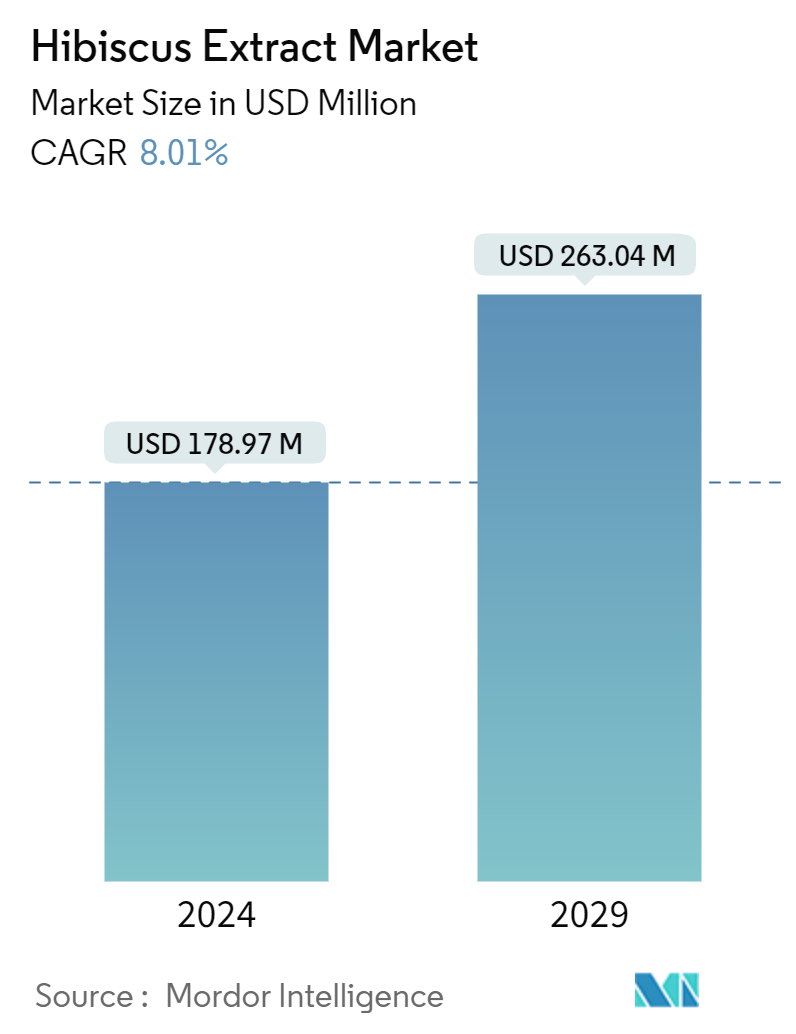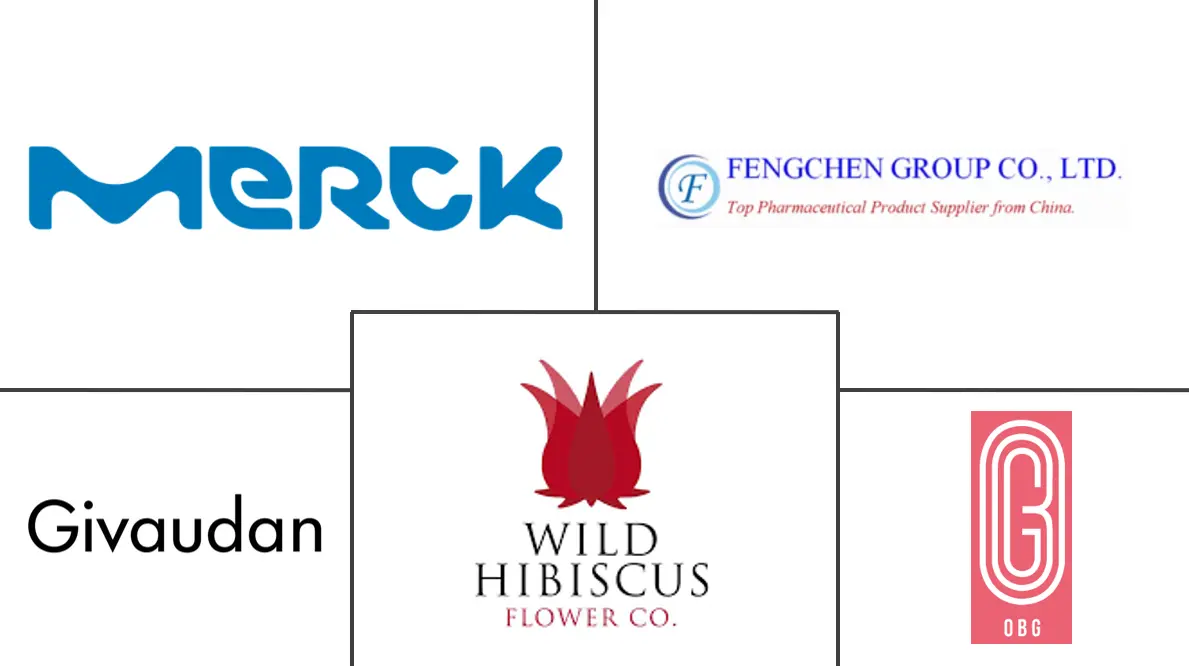Market Size of Hibiscus Extract Industry

| Study Period | 2019 - 2029 |
| Market Size (2024) | USD 178.97 Million |
| Market Size (2029) | USD 263.04 Million |
| CAGR (2024 - 2029) | 8.01 % |
| Fastest Growing Market | North America |
| Largest Market | Europe |
Major Players
*Disclaimer: Major Players sorted in no particular order |
Hibiscus Extract Market Analysis
The Hibiscus Extract Market size is estimated at USD 178.97 million in 2024, and is expected to reach USD 263.04 million by 2029, growing at a CAGR of 8.01% during the forecast period (2024-2029).
The demand for hibiscus powder has been increasing due to several factors that span health benefits, culinary uses, beauty and skincare applications, and growing trends in natural and organic products. Consumer demand for organic and natural food products is increasing. Also, the demand for clean-label and non-GMO ingredients is increasing, which is why the usage of hibiscus powder as flavor and color ingredients is rising. Hibiscus extract, recognized for its antioxidant and anti-inflammatory properties, is a crucial component in various healthy beverage products, including processed fruit juices and soft drinks. As the market for premium and organic beverages expands, the demand for hibiscus extracts within the food industry is also on the rise. According to the USDA Foreign Agriculture Services’ data from 2022, the consumption value of organic beverages in India was USD 92 million.
Moreover, hibiscus acts as a natural conditioner, making hair softer, smoother, and shinier. It helps in detangling hair and reducing frizz, which is why it is included in hair masks and leave-in conditioners. Consumers are increasingly looking for “clean” beauty products that are free from synthetic chemicals and harsh ingredients. Hibiscus, being a natural and plant-based ingredient, fits well into this trend. It is considered a safe and effective alternative to many synthetic ingredients. Owing to this, beauty and personal care manufacturers are adding hibiscus extracts to different hair care products like serums, oils, and conditioners. Market players like Veda Oils and Madura Herbals provide hibiscus powders and liquids for hair care and other personal care uses as well. Furthermore, other uses of hibiscus extracts include aroma therapy. The product is used in diffusers and fragrances to give a pleasant feeling. Thus, the demand for hibiscus extracts is expected to grow over the forecast period, owing to its increasing applications in different industries.
Hibiscus Extract Industry Segmentation
Hibiscus extract, sourced from the dried calyces of the Hibiscus sabdariffa flower, offers a robust nutritional profile. It is particularly rich in anthocyanins, which contribute to its distinctive red color and strong antioxidant properties. The global hibiscus extracts market is segmented by type, application, and geography. By form, the market is segmented into powder and liquid. By application, the market is segmented into food and beverages, pharmaceuticals, personal care, dietary supplements, and other applications. The market is segmented by geography into North America, Europe, Asia-Pacific, South America, and the Middle East and Africa. The market sizes and forecasts have been done in value terms (USD) for all the abovementioned segments.
| Type | |
| Powder | |
| Liquid |
| Application | |
| Food and Beverages | |
| Pharmaceuticals | |
| Personal Care | |
| Dietary Supplements | |
| Other Applications |
| Geography | |
| North America | |
| Europe | |
| Asia-Pacific | |
| South America | |
| Middle East and Africa |
Hibiscus Extract Market Size Summary
The hibiscus extract market is experiencing a robust expansion, driven by a growing consumer preference for natural and organic products across various industries. This trend is particularly prominent in the food and beverage sector, where hibiscus extract is valued for its antioxidant and anti-inflammatory properties, making it a popular ingredient in healthy beverages like processed fruit juices and soft drinks. The increasing demand for clean-label and non-GMO ingredients has further propelled the use of hibiscus powder as a natural flavor and color additive. In the beauty and personal care industry, hibiscus extract is gaining traction as a natural alternative to synthetic ingredients, being incorporated into hair care products for its conditioning and hair growth-promoting benefits. The rising consumer interest in clean beauty products is contributing to the growing utilization of hibiscus extracts in various personal care applications.
In Europe, the demand for hibiscus extracts is particularly strong, fueled by an aging population and a heightened focus on health and wellness. The extract's anti-aging properties, such as enhancing skin elasticity and providing exfoliating benefits, are driving its inclusion in anti-aging creams and health-focused pharmaceuticals. The increasing prevalence of heart disease has also led to a rise in hibiscus-infused supplements and pharmaceutical products, as hibiscus is believed to help reduce cholesterol and improve heart health. The global hibiscus extract market is characterized by a fragmented landscape with both regional and global players, such as Givaudan SA and Merck Group, actively engaging in strategic partnerships and product innovations to meet the rising demand for plant-based natural ingredients. These companies are also emphasizing sustainable sourcing and production practices to align with consumer preferences for eco-friendly products.
Hibiscus Extract Market Size - Table of Contents
-
1. MARKET DYNAMICS
-
1.1 Market Drivers
-
1.1.1 Increasing Consumer Consciousness About Natural Ingredients
-
1.1.2 Rising Popularity of Fortified/Functional Food and Beverages
-
-
1.2 Market Restraints
-
1.2.1 Stiff Competition from Alternative Extracts
-
-
1.3 Porter's Five Forces Analysis
-
1.3.1 Threat of New Entrants
-
1.3.2 Bargaining Power of Buyers/Consumers
-
1.3.3 Bargaining Power of Suppliers
-
1.3.4 Threat of Substitute Products
-
1.3.5 Intensity of Competitive Rivalry
-
-
-
2. MARKET SEGMENTATION
-
2.1 Type
-
2.1.1 Powder
-
2.1.2 Liquid
-
-
2.2 Application
-
2.2.1 Food and Beverages
-
2.2.2 Pharmaceuticals
-
2.2.3 Personal Care
-
2.2.4 Dietary Supplements
-
2.2.5 Other Applications
-
-
2.3 Geography
-
2.3.1 North America
-
2.3.2 Europe
-
2.3.3 Asia-Pacific
-
2.3.4 South America
-
2.3.5 Middle East and Africa
-
-
Hibiscus Extract Market Size FAQs
How big is the Hibiscus Extract Market?
The Hibiscus Extract Market size is expected to reach USD 178.97 million in 2024 and grow at a CAGR of 8.01% to reach USD 263.04 million by 2029.
What is the current Hibiscus Extract Market size?
In 2024, the Hibiscus Extract Market size is expected to reach USD 178.97 million.

